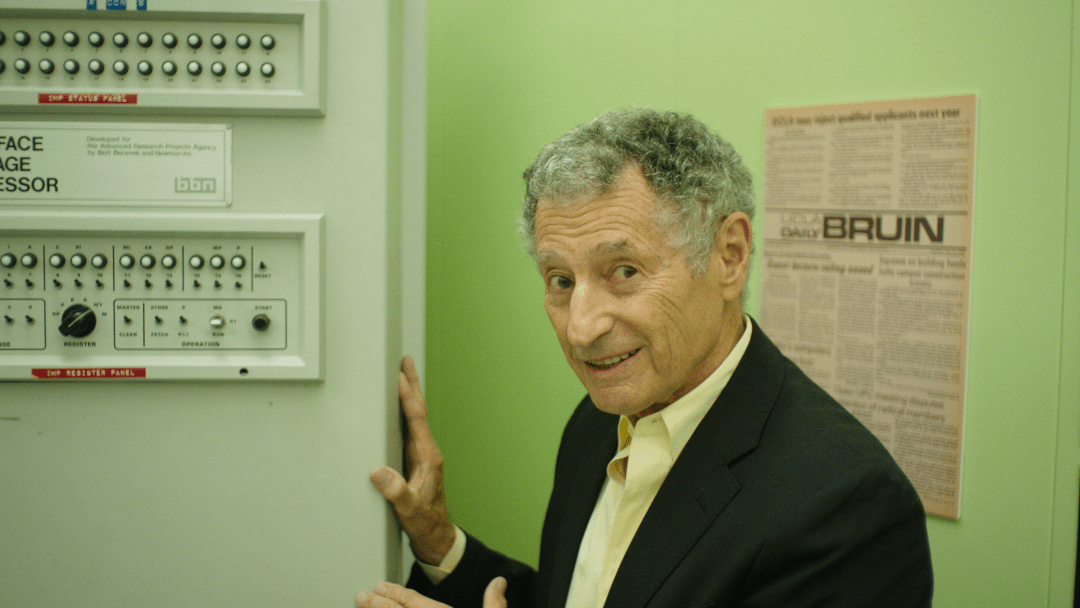
Professor Leonard Kleinrock with UCLA's Interface Message Processor (IMP). Photo courtesy UCLA
When Professor Leonard Kleinrock, one of the early pioneers of the internet, contacted us with questions about the Flair Puck, we were thrilled. Here was one of the inventors of the internet, contacting us with questions about Pucks and Smart Vents! We knew we had to ask him a few questions about the Internet of Things (IoT).
Leonard Kleinrock is the Distinguished Professor of Computer Science at UCLA. He developed the mathematical theory of packet networks while a graduate student at MIT. In September 1969, his host computer at UCLA became the first node of the internet. On October 29, 1969, he directed the transmission of the first message over the internet.
Some of you might recognize Professor Kleinrock from his appearance in Werner Herzog’s documentary on the internet, Lo and Behold: Reveries of the Connected World. You can see him in the film's trailer below:
We talked with Professor Kleinrock over the phone to hear his thoughts about the Internet of Things. In a way, he predicted the emergence of IoT. In a July 1969 UCLA press release, he predicted that computer networks would “grow up and become more sophisticated,” turning into utilities that “service individual homes and offices across the country.”
Our conversation with Professor Kleinrock will be published in two parts. You can find a href="https://flair.co/blogs/news/part-ii-leonard-kleinrock-iot-flair-interview" title="Part 2 of interview with Leonard Kleinrock talking Flair Pucks and Smart Vents">Part 2 here. This interview has been lightly edited for clarity.
When you emailed, everyone at Flair thought it was amazing that someone involved in the creation of the internet was interested in our Pucks and Smart Vents. The internet's gone through huge upheavals every decade or so since you first set up the IMPs at UCLA in the fall of 1969. Now we have the internet of Things. Based on your long-term perspective of the development of the internet what are some of the potentials of the Internet of Things?
Well, the Internet of Things is another phase in a long-term revolution if you will. Before the IMPs, I was quoted in a UCLA press release where I basically said that the internet would be always on, always available. Anybody from any location with any device could access it at any time and it would be invisible.
What do you mean by invisible?
The invisibility part was the interesting part. By invisible, I mean it is as invisible just like electricity is. As far as the consumer can see, electricity is: you plug it in the wall and you get electricity. No messing around. It’s a very simple interface that’s disappeared into the infrastructure. In my mind, that is how the internet should appear. It should be as simple as that.
When I walk into a room, the room should know I am there. I should be able to talk to it. A speech or gesture of mine should be interpreted and it could provide a display or a hologram.
We’re not there yet, but we’re getting there!
Certainly, the internet is not invisible today. There are devices you carry around. Flair is an example. I have to learn it. But the Internet of Things is enabling A) the omnipresence of the internet wherever you go and B) a set of embedded technologies that allows us to hide the technology in the infrastructure and interact with it with voice, touch, gesture, haptics, and all of that.
The Internet of Things seems is a step in that direction, but it is not all the way there yet. We don't have a totally simple interaction with the internet.
Eventually where this is heading is what I like to refer to as a pervasive global nervous system. The entire planet will become enabled, aware of what's happening in environment where you can access it wherever you are.
That implies wireless technology, which is happening like gangbusters. It also implies that the very small embedded devices that provide the logic, the memory, the display, the microphones, the speakers, the storage, and all the rest is in the environment. It must disappear into the walls, your desk, your fingernails, your body, your room, your car, etc.
What are the challenges of getting to that point?
Everybody is moving in that direction in a haphazard way. There is no overall structure, but I am not sure that we need to impose a formal structure at this point. Eventually, I believe that the marketplace will settle in on the right kind of interfaces. At the moment, everybody’s interface is different.
Of course, the one bright side of this is that the younger generation has grown up with smartphones, with apps where each one is a little different. They accommodate them very easily. It may be that the old warhorses like myself are just too stiff, as opposed to these kids who are flexible and can adapt to it.
And so, it's best to let the world, the consumer, and humanity decide what they want, rather than try to impose it from above. We’ve seen this before with Ethernet, with IP, with fighting off the OSI, and with other standards that come from above. Every time we try to impose standards from above, as opposed to a grassroots effort from below, the grassroots effort always wins.
Click here for Part 2 of our interview with Professor Leonard Kleinrock!




